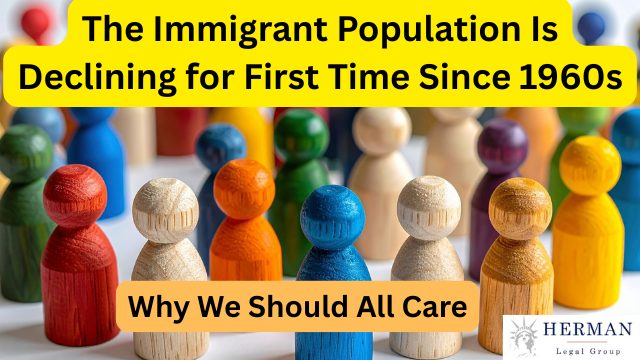Quick Answer
For the first time in 60 years, the U.S. foreign-born population—once steadily rising—is now shrinking, marking a significant shift in the nation’s immigrant population. This change affects every level of society: jobs, innovation, taxes, and community vitality.
Recent reports in late 2025 confirm that immigration inflows have slowed dramatically, deportations and voluntary departures have risen, and America’s competitors are capturing the talent we’re losing. This reduction in the immigrant population is largely attributed to increased arrests, deportations, and stricter immigration policies implemented under the Trump administration. Census Bureau data finds that the decline in the immigrant population is supported by multiple sources, reinforcing the trend.
At a Glance — Fast Facts on the Decline
- Fast Fact: In January 2025, the foreign-born (immigrant) population reached roughly 53.3 million people (15.8 percent of U.S. residents) (Center for Immigration Studies). Most immigrants live in major metropolitan areas such as New York, Los Angeles, Miami, and Houston.
- By June 2025 it had dropped to about 51.9 million (15.4 percent) — the first decline since the 1960s (Pew Research Center).
- Mexico remains the largest origin country for U.S. immigrants, accounting for nearly a quarter of the foreign-born population.
- From January to July 2025, the foreign-born population fell by roughly 2.2 million, including 1.6 million fewer non-citizens (CIS Report). These population estimates are based on CPS data from the Current Population Survey, which is widely used to track changes in the immigrant population.
- Essential Info: In September 2025, the Congressional Budget Office forecast that the U.S. population will be 4.5 million lower by 2035 than previously projected due to reduced immigration and fertility (CBO Update).
- The Federal Reserve Bank of Dallas noted in August 2025 that net unauthorized migration could decline by 2.4 million through 2028 (Dallas Fed Analysis).
- More than 1.2 million immigrants have left the U.S. labor force since January 2025 (ABC News). The immigrant population contributed to the entire growth of the U.S. population between 2022 and 2023, marking a significant demographic shift.
Why Is the US Immigrant Population Falling?
Restrictive Immigration Policies (2017–2025)
Important Note:
Policy tightening since 2017 — ranging from new vetting rules to stricter border enforcement — has limited both legal entries and unauthorized flows. The U.S. immigration policy has also included extensive executive actions under President Trump, resulting in mass deportations and fewer new immigrants (CalMatters Analysis).
Falling Birth Rates and Demographic Aging
Immigrants once offset America’s low fertility rates; that advantage is fading. Immigrant birth rates are dropping and the average age is rising, reducing net growth. As a result, population growth is now increasingly dependent on the natural increase—measured as births minus deaths—within the native born population. The native born population, which includes individuals born in the U.S., is primarily influenced by fertility and mortality rates, while foreign-born populations are affected by immigration flows. Additionally, the proportion of Mexican immigrants in the U.S. dropped from 29% in 2010 to 22% in 2023, reflecting broader demographic shifts.
COVID-19 and Processing Backlogs
Pandemic-era closures and delays still affect visa and asylum processing. Green card holders and those in the naturalization process have also experienced significant setbacks due to these backlogs, with many facing prolonged wait times for permanent residency or citizenship. Individuals with temporary protected status have faced additional uncertainty as processing delays impact their ability to maintain work authorization and protection from deportation. Visa backlogs and slow resettlement continue to limit arrivals. Policy changes starting in mid-2024 have also influenced the U.S. immigrant population, leading to a substantial decrease in border crossings for asylum seekers.
Rising Departures, Census Bureau Data, and Survey Non-Response
Between January and July 2025, about 2.2 million foreign-born individuals disappeared from Census surveys — some due to deportations and voluntary returns, others possibly under-counting. The Census Bureau’s surveys, such as the Current Population Survey (CPS) and the American Community Survey (ACS), play a crucial role in tracking these changes, and Census Bureau data is considered highly reliable for analyzing U.S. immigrant population trends. Population estimates are directly affected by survey non-response and fluctuations in the unauthorized population, making accurate data collection essential for understanding demographic shifts.
Unauthorized immigrants in the U.S. had reached a record high of 14 million in 2023, but this population began to decline as deportations increased and fewer crossed the border.
Global Competition for Talent
Countries such as Canada, the U.K. and Australia now offer streamlined immigration pathways, diverting STEM and medical talent from the U.S. While the U.S. is home to more immigrants than any other country, United Nations data shows that other countries, such as Canada and the United Arab Emirates, have a higher proportion of immigrants relative to their total populations. According to the United Nations, Germany has the second largest immigrant population globally after the U.S. Within the U.S., the second largest immigrant group by country of origin is from Mexico, following the largest group from India. Historically, most immigrants to the U.S. came from Northern and Western Europe, especially Western Europe, but in recent decades, the primary sources have shifted to Latin America and South America, reflecting broader regional changes in immigrant origins.
Why It Matters — Economic and Social Ripple Effects
Labor Force, Workforce, and Jobs
Immigrants make up nearly one-fifth of America’s labor force. A shrinking immigrant pool means fewer workers in key sectors and increased labor shortages (ABC News Labor Report). As of 2023, 46% of immigrants in the U.S. were naturalized citizens, making them the largest share of the immigrant population.
Demographic Aging and Fiscal Impact
Fewer working-age immigrants exacerbate population aging and stress Social Security and Medicare funding (Axios Analysis).
Innovation and Entrepreneurship
Immigrants have long fueled startups and technology growth. Their decline undermines innovation capacity (Immigration Impact).
Regional Focus — Ohio
Cleveland and Columbus rely on immigrant entrepreneurs and STEM talent to revitalize communities. Declining immigration threatens their economic momentum.
How America’s Competitors Are Winning the Talent War
| Country | Immigration Strategy | Outcome |
|---|---|---|
| Canada | Points-based system favoring skilled workers | Strong growth in skilled immigration |
| United Kingdom | Expanded Skilled Worker and Global Talent visas | Aggressive recruitment of STEM talent |
| Australia | Regional migration incentives | Balanced population growth |
Local Focus — Ohio Case Study
Cleveland
Immigrants revitalized neighborhoods and filled critical jobs. As inflows slow, reinvestment risks stalling.
Expert Tip: Regional planning should include immigrant attraction as core economic policy.
Columbus
Home to major universities and STEM industries, Columbus depends on international students and skilled immigrants for growth. Declines threaten its innovation pipeline.
Policy Outlook — Can the Decline Be Reversed?
What Could Help
- Enact the DREAM Act and expand STEM-visa pathways.
- Launch state and city “Welcome Initiatives.”
- Reduce processing backlogs at USCIS.
What Could Make It Worse
- Expanding enforcement-only measures could accelerate outflows (CalMatters Report).
- Global competitors continue to capture talent while U.S. opportunities narrow.
Where to Get Legal Help
- Herman Legal Group — Cleveland and Columbus; 30 + years of practice; multilingual services (LawFirm4Immigrants.com).
- Fragomen Del Rey Bernsen & Loewy LLP — Corporate immigration practice.
- Berry Appleman & Leiden LLP — Global talent solutions.
- Seyfarth Shaw LLP — Employment & immigration law.
- Ogletree Deakins — Compliance and litigation specialists.
Resources and Further Reading
- USCIS Policy Manual
- Migration Policy Institute State Profiles
- American Immigration Council
- CBO Demographic Outlook 2025–2055
- Dallas Fed Study on Migration Decline
Key Takeaways
- The U.S. immigrant population has declined for the first time in decades, dropping from 53.3 million to 51.9 million in 2025. This change raises the question of how many immigrants currently reside in the U.S., highlighting a significant shift in the overall US immigrant population.
- Late-2025 data from Pew, CIS, and the CBO confirm the trend is real and historically unprecedented. The Pew Research Center analysis provides detailed data on immigrant populations and the country’s foreign born population, confirming the decline and its implications.
- The overwhelming majority of immigrants are born abroad, with a significant share being naturalized citizens or lawful permanent residents (also known as green card holders). Many U.S. citizens have obtained their status through the naturalization process, further shaping the demographic landscape.
- The New York City metropolitan area remains the largest hub for immigrants in the U.S., with diverse communities including the Mexican born population, which continues to be the largest immigrant group despite recent declines.
- Causes: policy tightening, processing delays, lower birth rates, rising departures, and global competition.
- Economic consequences: labor shortages, slower growth, aging population.
- Solutions: pro-immigration reforms and state initiatives to retain talent.
- Action Step: Consult experienced immigration counsel such as Herman Legal Group to understand how these trends affect your family or business.








